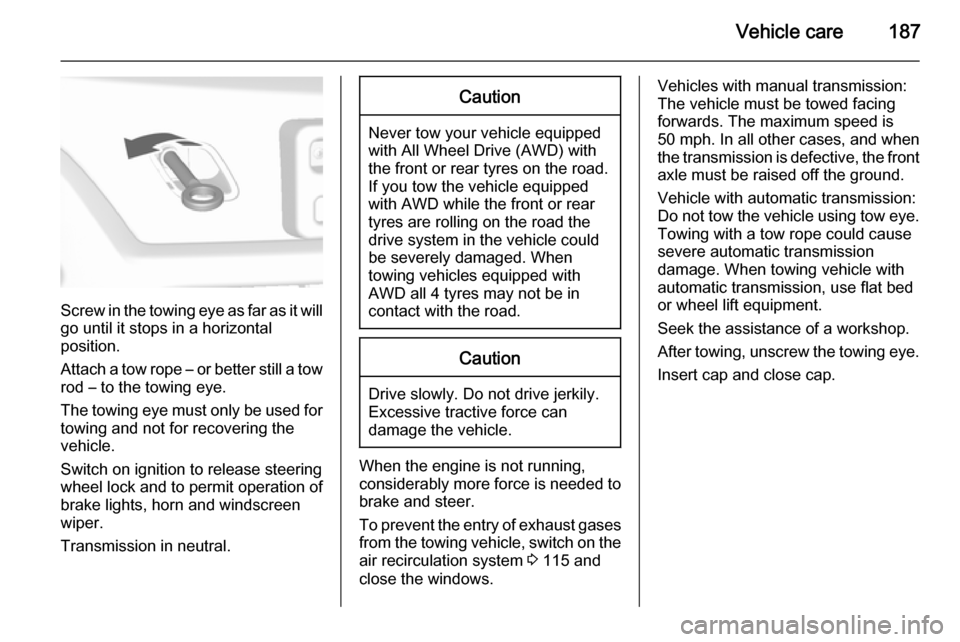wheel VAUXHALL MOKKA 2014 Repair Manual
[x] Cancel search | Manufacturer: VAUXHALL, Model Year: 2014, Model line: MOKKA, Model: VAUXHALL MOKKA 2014Pages: 217, PDF Size: 5.9 MB
Page 186 of 217

184Vehicle care
3. Place the hook end of the strapthrough the loop and pull it until
the strap is fastened securely to
the lashing eye.
4. Insert the strap through the spokes of the wheel as shown in
the illustration.
5. Mount the hook to the opposite lashing eye.
6. Tighten the strap and secure it using the buckle.
9 Danger
Always drive with folded up and
engaged rear seat backrests when stowing a damaged full size wheel
in the load compartment.
Temporary spare wheel
Caution
The use of a spare wheel that is smaller than the other wheels or in combination with winter tyres
could affect driveability. Have the defective tyre replaced as soon as
possible.
Only mount one temporary spare
wheel. Do not drive faster than
50 mph. Take curves slowly. Do not
use for a long period of time.
If your vehicle gets a flat tyre on the
rear while towing another vehicle,
mount the temporary spare wheel in
the front and the full size tyre in the
rear.
Tyre chains 3 177.
Directional tyres
Fit directional tyres such that they roll
in the direction of travel. The rolling
direction is indicated by a symbol
(e.g. an arrow) on the sidewall.
The following applies to tyres fitted
opposing the rolling direction:
■ Driveability may be affected. Have the defective tyre renewed or
repaired as soon as possible.
■ Drive particularly carefully on wet and snow-covered road surfaces.
Page 189 of 217

Vehicle care187
Screw in the towing eye as far as it will
go until it stops in a horizontal
position.
Attach a tow rope – or better still a tow
rod – to the towing eye.
The towing eye must only be used for towing and not for recovering the
vehicle.
Switch on ignition to release steering
wheel lock and to permit operation of
brake lights, horn and windscreen
wiper.
Transmission in neutral.
Caution
Never tow your vehicle equipped
with All Wheel Drive (AWD) with the front or rear tyres on the road.
If you tow the vehicle equipped with AWD while the front or rear
tyres are rolling on the road the
drive system in the vehicle could
be severely damaged. When
towing vehicles equipped with
AWD all 4 tyres may not be in
contact with the road.
Caution
Drive slowly. Do not drive jerkily.
Excessive tractive force can
damage the vehicle.
When the engine is not running,
considerably more force is needed to
brake and steer.
To prevent the entry of exhaust gases from the towing vehicle, switch on the
air recirculation system 3 115 and
close the windows.
Vehicles with manual transmission:
The vehicle must be towed facing
forwards. The maximum speed is
50 mph. In all other cases, and when
the transmission is defective, the front axle must be raised off the ground.
Vehicle with automatic transmission:
Do not tow the vehicle using tow eye.
Towing with a tow rope could cause
severe automatic transmission
damage. When towing vehicle with
automatic transmission, use flat bed
or wheel lift equipment.
Seek the assistance of a workshop.
After towing, unscrew the towing eye.
Insert cap and close cap.
Page 191 of 217

Vehicle care189Appearance care
Exterior care
Locks The locks are lubricated at the factoryusing a high quality lock cylinder
grease. Use de-icing agent only when
absolutely necessary, as this has a
degreasing effect and impairs lock function. After using a de-icing agent, have the locks regreased by a
workshop.
Washing
The paintwork of your vehicle is
exposed to environmental influences. Wash and wax your vehicle regularly.
When using automatic vehicle
washes, select a programme that
includes waxing.
Bird droppings, dead insects, resin,
pollen and the like should be cleaned
off immediately, as they contain
aggressive constituents which can
cause paint damage.If using a vehicle wash, comply with
the vehicle wash manufacturer's instructions. The windscreen wiperand rear window wiper must be
switched off. Remove antenna and
external accessories such as roof
racks etc.
If you wash your vehicle by hand,
make sure that the insides of the
wheel housings are also thoroughly
rinsed out.
Clean edges and folds on opened
doors and the bonnet as well as the
areas they cover.Caution
Always use a cleaning agent with
a pH value of 4 to 9.
Do not use cleaning agents on hot surfaces.
Have the door hinges of all doors
greased by a workshop.
Do not clean the engine compartment with a steam-jet or high-pressure jet
cleaner.
Thoroughly rinse and leather-off the vehicle. Rinse leather frequently. Use
separate leathers for painted and
glass surfaces: remnants of wax on
the windows will impair vision.
Exterior lights
Headlight and other light covers are
made of plastic. Do not use any
abrasive or caustic agents, do not use an ice scraper, and do not clean them
dry.
Polishing and waxing Wax the vehicle regularly (at the
latest when water no longer beads).
Otherwise, the paintwork will dry out.
Polishing is necessary only if the paint
has become dull or if solid deposits
have become attached to it.
Paintwork polish with silicone forms a
protective film, making waxing
unnecessary.
Plastic body parts must not be treated with wax or polishing agents.
Page 192 of 217

190Vehicle care
Windows and windscreen wiperblades
Use a soft lint-free cloth or chamois leather together with window cleanerand insect remover.
When cleaning the rear window from
inside, always wipe in parallel to the
heating element to prevent damage.
For mechanical removal of ice, use a
sharp-edged ice scraper. Press the
scraper firmly against the glass so
that no dirt can get under it and
scratch the glass.
Clean smearing wiper blades with a
soft cloth and window cleaner.
Wheels and tyres
Do not use high-pressure jet
cleaners.
Clean rims with a pH-neutral wheel
cleaner.
Rims are painted and can be treated
with the same agents as the body.Paintwork damage
Rectify minor paintwork damage with
a touch-up pen before rust forms.
Have more extensive damage or rust
areas repaired by a workshop.
Underbody
Some areas of the vehicle underbody
have a PVC undercoating while other critical areas have a durable
protective wax coating.
After the underbody is washed, check
the underbody and have it waxed if
necessary.
Bitumen/rubber materials could
damage the PVC coating. Have
underbody work carried out by a
workshop.
Before and after winter, wash the
underbody and have the protective
wax coating checked.Liquid gas system9 Danger
Liquid gas is heavier than air and
can collect in sink points.
Take care when performing work
at the underbody in a pit.
For painting work and when using a
drying booth at a temperature above
60 °C, the liquid gas tank must be
removed.
Do not make any modifications to the
liquid gas system.
Towing equipment Do not clean the coupling ball bar with
a steam-jet or high-pressure jet
cleaner.
Rear carrier system Clean the rear carrier system with a
steam-jet or high-pressure jet cleaner
at least once a year.
Operate the rear carrier system
periodically if not in regular use, in
particular during winter.
Page 203 of 217
![VAUXHALL MOKKA 2014 Repair Manual Technical data201PerformanceEngineA14NETA16XERA18XERA17DTSMaximum speed2)
[mph]Manual transmission116106112118/115 3)Automatic transmission––1121142)
The maximum speed indicated is achievable at VAUXHALL MOKKA 2014 Repair Manual Technical data201PerformanceEngineA14NETA16XERA18XERA17DTSMaximum speed2)
[mph]Manual transmission116106112118/115 3)Automatic transmission––1121142)
The maximum speed indicated is achievable at](/img/38/19524/w960_19524-202.png)
Technical data201PerformanceEngineA14NETA16XERA18XERA17DTSMaximum speed2)
[mph]Manual transmission116106112118/115 3)Automatic transmission––1121142)
The maximum speed indicated is achievable at kerb weight (without driver) plus 200 kg payload. Optional equipment
could reduce the specified maximum speed of the vehicle.
3) Vehicles with All-wheel drive system.
Page 204 of 217
![VAUXHALL MOKKA 2014 Repair Manual 202Technical dataVehicle weight
Kerb weight, basic model without any optional equipmentEngineManual transmissionAutomatic transmissionwithout/with air conditioning
[kg]A14NET1414/1425–A16XER1324/133 VAUXHALL MOKKA 2014 Repair Manual 202Technical dataVehicle weight
Kerb weight, basic model without any optional equipmentEngineManual transmissionAutomatic transmissionwithout/with air conditioning
[kg]A14NET1414/1425–A16XER1324/133](/img/38/19524/w960_19524-203.png)
202Technical dataVehicle weight
Kerb weight, basic model without any optional equipmentEngineManual transmissionAutomatic transmissionwithout/with air conditioning
[kg]A14NET1414/1425–A16XER1324/1335–A18XER1349/13601446/1457A17DTS1418/14291421/1432A17DTS 4)1479/1490–
Kerb weight, basic model with all optional equipment
EngineManual transmissionAutomatic transmissionwithout/with air conditioning
[kg]A14NET–/1534–A16XER–/1444–A18XER–/1461–/1558A17DTS–/1538–/1541A17DTS 4)–/1599–4)
Vehicles with All-wheel drive system.
Page 205 of 217
![VAUXHALL MOKKA 2014 Repair Manual Technical data203Vehicle dimensionsLength [mm]4278Width without exterior mirrors [mm]1764Width with two exterior mirrors [mm]2038Height (without antenna) [mm]1658Length of load compartment floor [mm]7 VAUXHALL MOKKA 2014 Repair Manual Technical data203Vehicle dimensionsLength [mm]4278Width without exterior mirrors [mm]1764Width with two exterior mirrors [mm]2038Height (without antenna) [mm]1658Length of load compartment floor [mm]7](/img/38/19524/w960_19524-204.png)
Technical data203Vehicle dimensionsLength [mm]4278Width without exterior mirrors [mm]1764Width with two exterior mirrors [mm]2038Height (without antenna) [mm]1658Length of load compartment floor [mm]729Length of load compartment with folded rear seats [mm]1428Load compartment width [mm]915Load compartment height [mm]757Wheelbase [mm]2555Turning circle diameter [m]11.5
Page 207 of 217
![VAUXHALL MOKKA 2014 Repair Manual Technical data205Tyre pressuresComfort with up to 3 peopleECO with up to 3 peopleWith full loadEngineTyresfrontrearfrontrearfrontrear[kPa/bar]
([psi])[kPa/bar]
([psi])[kPa/bar]
([psi])[kPa/bar]
([psi] VAUXHALL MOKKA 2014 Repair Manual Technical data205Tyre pressuresComfort with up to 3 peopleECO with up to 3 peopleWith full loadEngineTyresfrontrearfrontrearfrontrear[kPa/bar]
([psi])[kPa/bar]
([psi])[kPa/bar]
([psi])[kPa/bar]
([psi]](/img/38/19524/w960_19524-206.png)
Technical data205Tyre pressuresComfort with up to 3 peopleECO with up to 3 peopleWith full loadEngineTyresfrontrearfrontrearfrontrear[kPa/bar]
([psi])[kPa/bar]
([psi])[kPa/bar]
([psi])[kPa/bar]
([psi])[kPa/bar]
([psi])[kPa/bar]
([psi])A14NET,
A16XER,
A17DTS195/70 R16,200/2.0 (29)200/2.0 (29)270/2.7 (39)280/2.8 (41)270/2.7 (39)280/2.8 (41)205/70 R16,215/60 R17,215/65 R16215/55 R18220/2.2 (32)220/2.2 (32)270/2.7 (39)280/2.8 (41)270/2.7 (39)280/2.8 (41)A18XER195/70 R16,200/2.0 (29)200/2.0 (29)––200/2.0 (29)200/2.0 (29)205/70 R16215/55 R18220/2.2 (32)220/2.2 (32)––220/2.2 (32)220/2.2 (32)AllTemporary spare
wheel420/4.2 (61)420/4.2 (61)––420/4.2 (61)420/4.2 (61)
Page 209 of 217

Customer information207Customer informationCustomer information................207
Vehicle data recording and pri‐
vacy ........................................... 207Customer information
Declaration of conformity
This vehicle has systems that
transmit and/or receive radio waves
subject to Directive 1999/5/EC.
These systems are in compliance
with the essential requirements and
other relevant provisions of
Directive 1999/5/EC. Copies of the
original Declarations of Conformity
can be obtained on our website.Vehicle data recording
and privacy
Event data recorders
Data storage modules in the
vehicle
A large number of electronic
components of your vehicle contain
data storage modules temporarily or
permanently storing technical data
about the condition of the vehicle,
events and errors. In general, this
technical information documents the
condition of parts, modules, systems
or the environment:
■ Operating conditions of system components (e.g. filling levels)
■ Status messages of the vehicle and
its single components (e.g. number of wheel revolutions / rotational
speed, deceleration, lateral
acceleration)
■ Dysfunctions and defects in important system components
Page 212 of 217

210IndexAAccessories and vehicle modifications .......................... 152
Adaptive forward lighting .....87, 107
Adjustable air vents ...................118
Airbag and belt tensioners ...........83
Airbag deactivation ................46, 83
Airbag system .............................. 41
Air conditioning regular operation ................................ 119
Air conditioning system .............. 115
Air intake .................................... 119
Air vents...................................... 118
All-wheel drive ........................... 130
Antilock brake system ................ 131
Antilock brake system (ABS) .......85
Anti-theft alarm system ................25
Anti-theft locking system .............. 25
Appearance care ........................189
Automatic anti-dazzle ..................28
Automatic light control ...............104
Automatic locking ........................23
Automatic transmission .............127
Auxiliary heater ........................... 118
B Battery discharge protection ......113
Battery voltage ............................. 95
Bicycle rack .................................. 57Bonnet ....................................... 154
Bonnet open ................................. 88
Brake and clutch fluid .................193
Brake and clutch system .............84
Brake assist ............................... 132
Brake fluid .................................. 157
Brakes ............................... 131, 157
Breakdown.................................. 186
Bulb replacement ....................... 160
C
Capacities .................................. 204
Catalytic converter .....................126
Central locking system ................21
Centre console storage ...............56
Centre high-mounted brake light 165
Changing tyre and wheel size ...176
Charging system .......................... 84
Child locks ................................... 23
Child restraint installation locations ................................... 49
Child restraints.............................. 47
Child restraint systems ................47
Climate control ............................. 15
Climate control systems .............114
Clock ............................................ 76
Code ............................................. 93
Control indicators.......................... 81
Control of the vehicle .................120
Controls ........................................ 72